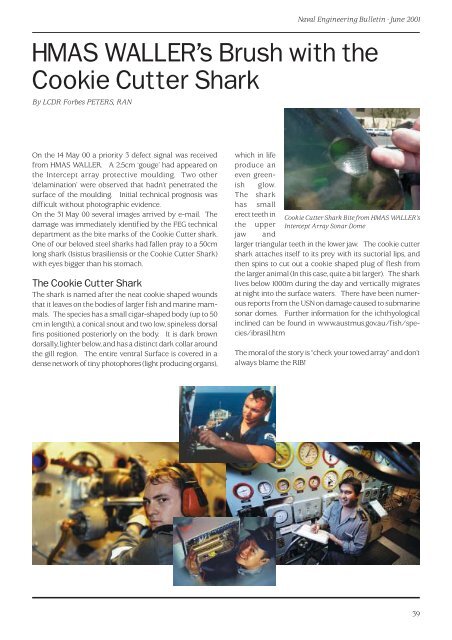Engineering - Royal Australian Navy
Engineering - Royal Australian Navy
Engineering - Royal Australian Navy
You also want an ePaper? Increase the reach of your titles
YUMPU automatically turns print PDFs into web optimized ePapers that Google loves.
Naval <strong>Engineering</strong> Bulletin • June 2001<br />
HMAS WALLER’s Brush with the<br />
Cookie Cutter Shark<br />
By LCDR Forbes PETERS, RAN<br />
On the 14 May 00 a priority 3 defect signal was received<br />
from HMAS WALLER. A 2.5cm ‘gouge’ had appeared on<br />
the Intercept array protective moulding. Two other<br />
‘delamination’ were observed that hadn’t penetrated the<br />
surface of the moulding. Initial technical prognosis was<br />
difficult without photographic evidence.<br />
On the 31 May 00 several images arrived by e-mail. The<br />
damage was immediately identified by the FEG technical<br />
department as the bite marks of the Cookie Cutter shark.<br />
One of our beloved steel sharks had fallen pray to a 50cm<br />
long shark (Isistus brasiliensis or the Cookie Cutter Shark)<br />
with eyes bigger than his stomach.<br />
The Cookie Cutter Shark<br />
The shark is named after the neat cookie shaped wounds<br />
that it leaves on the bodies of larger fish and marine mammals.<br />
The species has a small cigar-shaped body (up to 50<br />
cm in length), a conical snout and two low, spineless dorsal<br />
fins positioned posteriorly on the body. It is dark brown<br />
dorsally, lighter below, and has a distinct dark collar around<br />
the gill region. The entire ventral Surface is covered in a<br />
dense network of tiny photophores (light producing organs),<br />
which in life<br />
produce an<br />
even greenish<br />
glow.<br />
The shark<br />
has small<br />
erect teeth in<br />
the upper<br />
jaw and<br />
Cookie Cutter Shark Bite from HMAS WALLER’s<br />
Intercept Array Sonar Dome<br />
larger triangular teeth in the lower jaw. The cookie cutter<br />
shark attaches itself to its prey with its suctorial lips, and<br />
then spins to cut out a cookie shaped plug of flesh from<br />
the larger animal (In this case, quite a bit larger). The shark<br />
lives below 1000m during the day and vertically migrates<br />
at night into the surface waters. There have been numerous<br />
reports from the USN on damage caused to submarine<br />
sonar domes. Further information for the ichthyological<br />
inclined can be found in www.austmus.gov.au/fish/species/ibrasil.htm<br />
The moral of the story is “check your towed array” and don’t<br />
always blame the RIB!<br />
39
















